

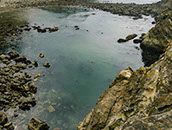
Climate and weather: two words that seem similar, sometimes mistaken for each other, but tell different complex stories. Weather is in the short term, including the chance of rain, thunderstorms, and snow. But climate is long term. Climate indicates trends, the accumulated data for weather over time for a region. When studying climate science, researchers use empirical data to show existing and forecasted climate patterns. This gives them perspective on how climate is shifting.
As part of the Science & Memory Oregon Coast Expedition 2017, we looked for data that explains how this region will be affected by climate changes over the next decade.
1 Insurance Surges: Oregonians will pay more
With rising coastal waters and extreme weather events in all seasons, flood and home insurance is more necessary than ever before. The Oregon coast has experienced more extreme weather in recent years including increased flooding, snowfall, drought, and wildfires. With this increase insurance companies are reevaluating the cost of premiums and deciding whether homes in the high risk flood areas can be insured at all. Amy Bach, executive director of United Policyholders, an advocacy group focused on insurance, said that it is not uncommon to have four or five figure premiums, specifically in coastal regions such as the Oregon coast.
Oregon has 258 cities and counties located in areas subject to flooding. In 2012, the Biggert-Waters Flood Insurance Reform Act of 2012 was passed by U.S Congress authorizing rate increase according to your proximity to the flood zones. This act was partially repealed by the Homeowner Flood Insurance Affordability Act of 2014, putting certain restrictions on premiums and reassessing the risk of certain flood areas. Although the original act was repealed, as extreme weather continues to increase causing wildfires, floods, and droughts in Oregon, many residents’ premiums will continue to increase and some may find themselves uninsurable.
Similarly, home insurance costs covering weather events such as ice storms will rise as weather records do. In short: homeowners pay for extreme weather. The increase in global temperature directly affects weather, which affects homes and safety.
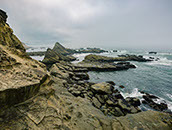
2 Sea Levels on the Rise: Loss of habitat and land
The Intergovernmental Panel on Climate Change (IPPC), which produces the most comprehensive models of global sea level rise, estimates that global sea level has risen 1.7mm per year over the 20th century. This may not seem like a high amount, but in the long term, this increase will be detrimental to coastal wetlands, estuaries, and beaches. Specifically, estuaries which provide shelter for anadromous fish (i.e salmon) will be at risk. There are 43 estuaries on the Oregon coast; 70-90 percent of tidal wetland habitat has been altered or lost in the past 150 years, in response to global warming, which increases ocean temperature. For example, in the South Slough Reserve, an estuary on the Oregon Coast, pH has dramatically increased since 1995. This increase results from the absorption of CO2 by oceans and the inability of them to dispel that CO2.*
These historical impacts in combination with sea level rise will result in devastating loss to vital ecosystems. These ecosystems may be able to withstand small amounts of change, but in the long run, the rivers will not be able to keep pace, resulting in destroyed habitats, loss of marine life, and flooding of the inland areas.
3 Transportation: Infrastructure and impact
Transportation is vital to Oregon’s infrastructure, including the movement of food, manufacturing, and trade. We take advantage of the scenic routes we have in Oregon; 2,800 miles of roads wind through the coastal communities, but what’s not apparent is that all of those roads are located in the 100-year flood plain. As sea levels and storms increase rivers, estuaries and coastal wetlands won’t be able to keep up. In 2016, a large portion of highway 101 located in Gold Beach on the Oregon Coast was completely washed away, directly impacting the route loggers take for deliveries.
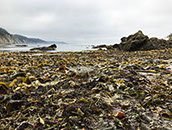
4 Erosion: Oregon Coast quality and property values affected
Large sprawling cliffs for miles, massive skyscraping trees, and water splashing aggressively off rocks: this is what the Oregon Coast is known for. Extreme weather events often lead to erosion on coastal landscape. Many Oregon beaches suffer a sand deficit, that is, there is no barrier between the sea and the backshore areas. A 2016 United States Geological Survey reported that portions of the Oregon Coast are currently eroding at a rate of 3 feet per year and 36 percent of the Oregon and Washington coasts currently experience erosion. Continuing at this rate or increasing could mean irreversible affects to coastal communities, including homes, businesses, schools and even hospitals.
Oregon had worked to combat this destruction by enacting the Oregon Beach Bill in 1967. This bill allowed Oregonians to have ownership and access to all beaches located on the coast; something only Hawaii and Oregon have done. This bill also prevented commercial and private infrastructure form being built close to the shoreline, diminishing the amount of destruction due to erosion, but in the long term there will still be devastating affects to inland areas. “The rates of erosion and frequency of coastal flooding have increased over the last couple of decades and will almost certainly increase in the future,” states Peter Ruggiero, an assistant professor in the Oregon State University Department of Geosciences. “The Pacific Northwest has one of the strongest wave climates in the world, and the data clearly show that it’s getting even bigger."
5 Extreme Weather: Disturbances to happen more frequently with more intensity
Drought, intense rain, wind and ice storms have increased in the last 50 years. Oregon is known for rain, but 2/3 of the state is actually desert; in 2015 official drought declarations were made for 25 out of 36 counties.* The only known multi-year marine heat wave came to a head during this year. Beginning in Alaska in 2013, it slowly made its way down; making landfall off the coast of Oregon in 2015. This heat wave caused detrimental damage to Oregon, including record breaking heat during summer and winter months between 2015-2016. This heat caused the winter season to be 5-6 degrees warmer resulting in what should have been snowfall to be rainfall. This extreme weather has direct effects to agriculture, marine life, wildfires and invasive species.
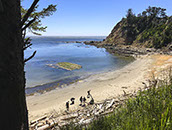
6 Agriculture: Oregon’s growing seasons will change
In Oregon, farming is a way of life; passed down from generations, communities are built around agriculture. Shifts in climate have a direct impact on our food crops, animals, and economy. Due to the extreme heat in 2015 farmers only received 1/3 of their supply of irrigation water because the Owyhee Water Reservoir located in far Eastern Oregon was low for the past 3 years. Oregon is no. 4 in the country in regards to dairy; when temperatures increase, animals become stressed and the output decreases.
Farming is vital to Oregon families and the economy. Agriculture brings 240,000 jobs and provides 15% of the economic activity in Oregon.* As climate change continues, winters have increased precipitation and a decrease in the longevity of the season, whereas summers are drier and last longer. A longer agricultural season means more crops, but without the standard amount of water, crops will be unable to grow.
7 Fish Die Off: Warmer water temperatures in ocean, rivers, and streams
Consider Oregon’s dependence on fish. Salmon, steelhead, and trout have populated streams for thousands of years. Fish need cooler waters to migrate and live. In 2016, more than half of spring spawn salmon in the Columbia River perished from a disease associated with the warmer than normal waters that occurred. The Bonneville Dam located along the Columbia River houses a fish ladder and the employees count fish yearly. The 10-year average for adult Chinook salmon totals to 150,783 whereas the count for this year only amounted to 83,624.
Not only did the unusually warm waters affect salmon in the Columbia River, it also affected commercial fishing on the Oregon Coast. The Pacific Fishery Management Council shut down sport and commercial fishing for chinook and coho salmon. They report that due to drought fish were plagued with a disease associated with warming waters. With the warming temperatures of the water fish, anadromous fish – salmon and steelhead, as example -- return later each year in decreasing numbers.
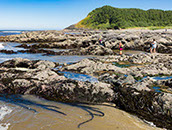
8 Wildfires: Drier weather increases burning
The summer of 2017 reminded us of the realities of wildfire and smoke-filled communities that play havoc with landscapes and with health. Lightning strikes combined with increasingly dry conditions cause wildfires, which can be costly and endanger people, their homes and animals. Firefighters from the U.S forest service, tribes and bureau of land management send teams to combat these fires, but with the lack of rain, it can easily get out of control. Oregon has been plagued with a particularly big year for wildfires; over 550,000 acres have been burned so far. This is just shy of the 685,809 acres that burned in 2015 and the 2017 fire season has yet to come to a close.
Not only do wildfires burn acres of landscape they also endanger homes and pollute the air. In 2013, the Union of Concerned Scientists released this statement: “The number of large wildfires — defined as those covering more than 1,000 acres — is increasing throughout the region. Over the past 12 years, every state in the Western U.S. has experienced an increase in the average number of large wildfires per year compared to the annual average from 1980 to 2000.”
Fires can also be utilized to maintain healthy forests and overgrowth of land; “controlled burns” or fires set intentionally for a positive purpose. Many plants and trees in our ecosystems need fire to reproduce and in some cases help reset conditions in the forest. In the past, we managed fires, but we did not allow the natural occurring fires to reset conditions causing landscapes to become overgrown. This management oversight in combination with extremely dry conditions caused by climate change has created a big problem. Mark Blaine, Senior Instructor II at the University of Oregon who has conducted research on wildfire mitigation, said, “We can’t turn the clock back and we’ve got to find a way forward with fire. That probably means more restrictions on how people build and where, and a rethinking of how we deal with things like smoke.”
9 Invasive Species: Insect epidemic wreak havoc on forests
At one point in the drive near Santiam Pass, you turn a corner and straight ahead is a vast landscape of rolling hills. If this is your first drive through the area, you will be shocked. The trees are barren for miles almost as if they were burned by wildfire, but although a fire had a small role in this destruction, the cause was one small insect – the mountain pine beetle. According to the Oregon Department of Forestry, this beetle was responsible for the destruction of 380,000 acres per year from 2007-2016. These beetles thrive in hot weather; with the vast acres of trees in Oregon and the record breaking heat recorded recently, this is a perfect place for an epidemic.
Currently many studies are being conducted regarding the mountain pine beetle, because it is most prevalent in the Pacific Northwest. One in particular is being conducted by scientists from Oregon State University, who gathered older data from airplane and ground surveys, combined them with new satellite imagery to locate where Mountain Pine Beetles damage trees. Helen Maffei, a scientist from the U.S Forest Service in Bend, states, “This new technique can help us understand not only how insect outbreaks are initiated and spread but also address the question, ‘What comes next’? It can help us better understand the process of recovery.”
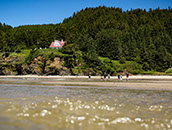
10 Change in Climate: CO2 emission impact weather patterns
Humans have increased the carbon dioxide in the air by 40 percent since the early 1800s. With burning of fossil fuels and clearing of trees, that absorb carbon dioxide, we are slowly warming the planet. The planet has warmed 1.5 degrees since 1960 and is expected to increase another 5 degrees by 2050 and 9 degrees by 2100.
In areas such as the Cascade Mountains that experience heavy snow and steady amounts of rain, this introduction of a more arid climate raises concerns for ski resorts, farmers, and commercial fisherman. Fish, such as salmon, will make their way north as the freeze line moves, the tourism industry will decline with the lack of snow at the ski resorts, and farmers will have less irrigation water to grow crops, causing a decline in the nation’s food supply and economy.
The lack of water will not only affect farmers but the state as a whole. With the decrease in precipitation and the lack of snowmelt, wildfires, drought, and invasive insects are expected to wreak havoc. Until fossil emissions are decreased we will continue to see these catastrophic events. Kathie Dello, associate director of the Oregon Climate Change Research Institute, states, “A lot of the studies we cited focus on the physical aspects of warming, from snowpack to wildfire, but there are a lot of people who will be affected. We can’t forget that Oregonians, their families, their jobs and their resources are at risk. There is still time to do something, but time is running short.”
*Dalton, M. M., Mote, P. W., & Snover, A. K. (2013). "Climate Change in the Northwest Implications for Our Landscapes, Waters, and Communities." Washington, DC: Island Press/Center for Resource Economics.
Five important resources to review for more information:
Inside Climate News: https://insideclimatenews.org/
A Pulitzer Prize-winning, independent and non-partisan site that reviews research and information about climate science and public policy.
National Climate Assessment: http://nca2014.globalchange.gov
The National Climate Assessment summarizes the impacts of climate change on the United States, now and in the future. A team of more than 300 experts guided by a 60-member Federal Advisory Committee produced the report, which was extensively reviewed by the public and experts, including federal agencies and a panel of the National
Academy of Sciences.
Oregon Climate Change Research Institute: http://www.occri.net
The vision of Oregon Climate Change Research Institute (OCCRI) is: to achieve climate prepared Northwest by building a climate knowledge network, cultivating climate-informed communities, and advancing the understanding of regional climate, impacts, and adaptation.
NASA Global Climate Change: https://climate.nasa.gov/resources/education/
The mission of “Global Climate Change: Vital Signs of the Planet” is to provide the public with accurate and timely news and information about Earth’s changing climate, along with current data and visualizations, presented from the unique perspective of NASA, the world’s leading climate research agency.
Oregon Global Warming Commission: http://www.keeporegoncool.org
The Commission’s general charge is to recommend ways to coordinate state and local efforts to reduce Oregon’s greenhouse gas emissions consistent with Oregon’s goals and to recommend efforts to help the state, local governments, businesses and residents prepare for the effects of global warming.
Photographs by Pam Cressall & Justin Hartney